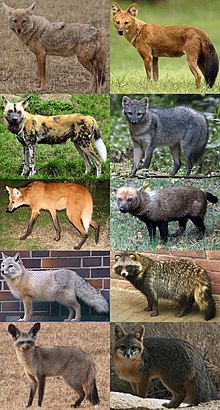
Back Hondagtiges Afrikaans የውሻ አስተኔ Amharic Canidae AN Hund ANG كلبيات Arabic كلبيات ARZ Canidae AST Idatcol (Canidae) AVK İtlər Azerbaijani کؤپککیمیلر AZB
| Canids | |
|---|---|
 | |
| 10 of the 13 extant canid genera | |
| Scientific classification | |
| Domain: | Eukaryota |
| Kingdom: | Animalia |
| Phylum: | Chordata |
| Class: | Mammalia |
| Order: | Carnivora |
| Infraorder: | Cynoidea |
| Family: | Canidae Fischer de Waldheim, 1817[2] |
| Type genus | |
| Canis Linnaeus, 1758
| |
| Subfamilies and genera | |
Canidae (/ˈkænɪdiː/;[3] from Latin, canis, "dog") is a biological family of dog-like carnivorans, colloquially referred to as dogs, and constitutes a clade. A member of this family is also called a canid (/ˈkeɪnɪd/).[4] The family includes three subfamilies: the Caninae, and the extinct Borophaginae and Hesperocyoninae.[5] The Caninae are known as canines,[6] and include domestic dogs, wolves, coyotes, foxes, jackals and other species.
Canids are found on all continents except Antarctica, having arrived independently or accompanied by human beings over extended periods of time. Canids vary in size from the 2-metre-long (6.6 ft)[citation needed] gray wolf to the 24-centimetre-long (9.4 in)[citation needed] fennec fox. The body forms of canids are similar, typically having long muzzles, upright ears, teeth adapted for cracking bones and slicing flesh, long legs, and bushy tails. They are mostly social animals, living together in family units or small groups and behaving co-operatively. Typically, only the dominant pair in a group breeds and a litter of young are reared annually in an underground den. Canids communicate by scent signals and vocalizations. One canid, the domestic dog, originated from a symbiotic relationship with Upper Paleolithic humans and is one of the most widely kept domestic animals.
- ^ Cite error: The named reference
tedford2009was invoked but never defined (see the help page). - ^ Fischer de Waldheim, G. 1817. Adversaria zoological. Memoir Societe Naturelle (Moscow) 5:368–428. p372
- ^ Canidae. Dictionary.com. The American Heritage Stedman's Medical Dictionary. Houghton Mifflin Company. http://dictionary.reference.com/browse/Canidae (accessed: 16 February 2009).
- ^ Wang & Tedford 2008, pp. 181.
- ^ Cite error: The named reference
miklosi2015was invoked but never defined (see the help page). - ^ Wang & Tedford 2008, pp. 182.